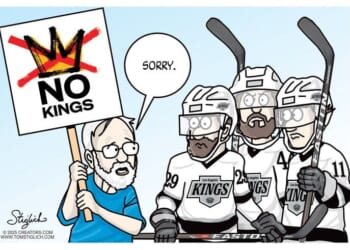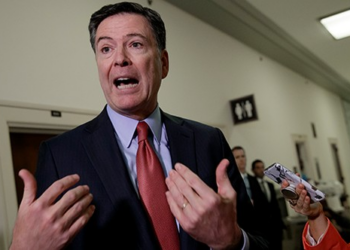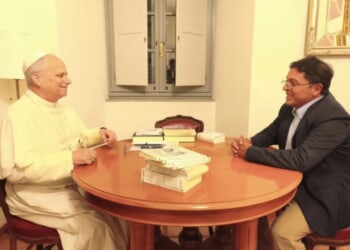There’s a historic film short that both captures the pinnacle of the Hollywood dream factory and sends the proverbial warning that pride goeth before a fall. The short depicts the MGM 25th Anniversary Luncheon that took place on April 25, 1949. At this point, Metro Goldwyn Mayer was the biggest motion picture studio on Earth “with more stars than there are in the heavens.” And there were plenty of them there, several becoming legends — Clark Gable (the “King” of Hollywood), Judy Garland, Fred Astaire, Ava Gardner, Gene Kelly, Spencer Tracy, Katharine Hepburn, Errol Flynn, and more. The war was over, the male stars were back, and MGM — and all the other studios — was gearing up for 25 more years of unrivaled entertainment supremacy. Yet just five years later, most of these star contracts had been terminated and MGM was struggling for survival.
You read it right. Doctor Who became too woke and queer even for Disney. But the virtue signal will outlast the show.
What few people in that luncheon and the wider movie industry could foresee was that in those five years, a tiny, visually frustrating electronic box would supplant all the big screen’s horses and all the big screen’s men — and radiant women — in popularity. So, on January 18th, 1953, more than 70 percent of all TV households were captivated by the birth of a fictional baby to a former second-tier MGM starlet, now the lead in I Love Lucy. This didn’t help the night’s box-office for MGM’s The Bad and the Beautiful, ironically the best film ever made about Hollywood, starring Kirk Douglas, Lana Turner, and Dick Powell. Perhaps if they’d had journalism like The Cultural Dispatch rather than fawning celebrity coverage, movie moguls could have been better prepared for the radical change.
Several sharp observers besides me predicted years ago the wreckage that is Hollywoke today. You cannot, we warned, maintain an art-based industry with singular false messaging advanced by hacks hired for their nonwhite-male status rather than any talent. You can’t displace patriotism with racism, religion with anti-Christianity, heterosexuality with homosexuality, action heroes with women, feminine beauty with girlboss bullying, romance with misandry and survive. The Hollywokers ignored us and invoked their own destruction.
I’ve thoroughly covered the feminist-driven destruction of once male-friendly franchises, such as Star Wars, the Marvel Comics Universe, Indiana Jones, and James Bond. You can add another iconic victim to the fatality list — Doctor Who. The adventures of the perennial sci-fi hero had been entertaining boys since I was one, when dynamic actors Jon Pertwee and Tom Baker played him successively from 1973 to 1981. Both displayed traditional British intelligence, wit, and courage against weird alien creatures.
Fortunately for us young men, they each also had a comely yet bright sidekick counterbalancing the extraterrestrial ugliness, Sarah Jane Smith (Elizabeth Sladen) and, even better, the scantily-clad Amazon Leela (Louise Jameson). The formula endured and spiked between 2005 and 2013 thanks to two equally compelling actors, David Tennant and Matt Smith. Tennant’s sexy companion was played by Billy Piper, who had the first, and very popular, overt romance with the Doctor.
Clever sci-fi, a masculine hero, and a bright, affectionate pretty woman — what more could guys want? It didn’t matter what we chauvinist pigs wanted, according to the woke mind virus infesting all screen fare of the past decade. Like it or not, we were getting a female Doctor, in 2018, played by the appropriately homely Jodie Whittaker. Hey, but at least she too had a cute, now obligatorily ethnic, sidekick (Pakistani British-Muslim actress Yasmin Khan) as her love interest. Yes, Whittaker was also the first lesbian Doctor Who.
Of course, the show’s ratings dopped like a stone. And of course Whittaker lashed out at the fan base rather than the new propaganda. “If some people can’t handle a woman in the role, that’s their problem, not mine,” she told the UK Guardian. “If you don’t like it, don’t watch it. It’s really very simple. We’re making this for the people who do want to see it — the kids, the new fans, the ones who see themselves in this Doctor. The rest can stay in 1973.”
The rest didn’t stay in 1973. They just stayed away. And to Doctor Who showrunner Russell T. Davies, this meant war — Culture War. He’d teach those neanderthal viewers a lesson. He’d give them a black queer Doctor Who, portrayed by an openly queer actor (Ncuti Gatwa). Not inclusive enough? Add a nonbinary sidekick played by a trans actor (Eden McRae). Still lacking? Cast a drag queen as the villain. And then throw in the standard insult. “Hate the queer Black Doctor?” Davies wrote in the Guardian. “That’s on you — not the show.”
Well, Davies certainly showed the fans — who just stopped being fans. One million racist homophobes quit watching the series en masse. The drop-off was so great, that last week, Disney pulled out of the Doctor Who coproduction deal with the BBC. You read it right. Doctor Who became too woke and queer even for Disney. But the virtue signal will outlast the show.
And that’s the difference between the old studio heads and the terminally woke of today. They never derided the audience, they catered to it. And when they couldn’t lick television, they joined it, to create beloved TV classics: MGM — The Twilight Zone, The Man from U.N.C.L.E., Warner Bros — Maverick, 77 Sunset Strip, Universal — Columbo, The Rockford Files, Paramount — Star Trek, Mission Impossible. 20th Century Fox (M*A*S*H, The Simpsons). No one’s going to miss Doctor Who.
READ MORE from Lou Aguilar:
Seven Chillers Without Drillers for Halloween
The Fall and Rise of American Culture
A Novel Look at the Culture War
Have yourselves a romantic little Christmas. Get your love interest my Yuletide romance fantasy novel, The Christmas Spirit. Available at Amazon, Barnes & Noble, or wherever fine books are still sold.


![Scott Bessent Explains The Big Picture Everyone is Missing During the Shutdown [WATCH]](https://www.right2024.com/wp-content/uploads/2025/11/Scott-Bessent-Explains-The-Big-Picture-Everyone-is-Missing-During-350x250.jpg)














